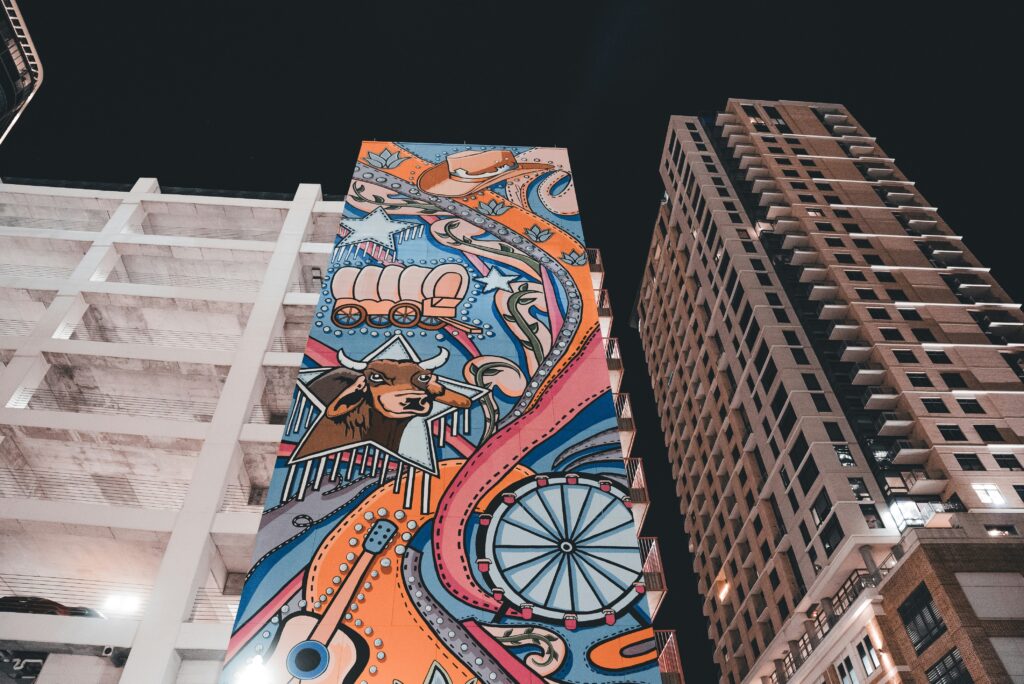From Sidewalk to Spotlight: Urban Art on the Global Stage
What started as rogue expression on train cars and underpasses is now hanging in major galleries from New York to Tokyo. Urban art, once dismissed as vandalism, has pushed into the mainstream without losing its grit. The crossover wasn’t luck. Over the past decade, institutions began to realize what the streets already knew: this work had power, urgency and a raw connection to culture that people showed up for.
But not all stories in this shift are the same. What makes this particular artist’s path stand out is how it bridges rebellion and refinement. They didn’t bend for the gallery scene. They kept the angles sharp, the voice loud and the roots visible. Their pieces hang on white walls now, but they still carry the rhythm of the street. That honesty cuts through trends. It’s not just style — it’s lived experience turned visual. That’s what collectors, critics and crowds are locking into.
The global art world finally caught up. What used to be painted in silence under streetlamps is now being auctioned with flashbulbs blazing. Yet at its core, this is still about message over medium. And for artists like this one, the message hasn’t changed — only the scale.
The story starts in a city that never knew quiet. Sirens, subways, protests, and concrete everywhere. A place where walls said more than billboards ever could. For early street artists, vlogging wasn’t the medium — street space was. Walls became raw canvas. A tag here, a mural there. It wasn’t about fame, not yet. It was about being seen by someone, anyone, in a city that looked away.
Backlash came fast. Cops called it graffiti. Politicians called it vandalism. But slipping through alleyways with spray cans and GoPros, these creators found something else — a growing underground that noticed. Online forums, secret screenings, social shares before the algorithm cared. The early support came on the margins, and that’s where it grew.
It wasn’t polished, but it was honest. Unfiltered. People connected with that. And slowly, what was dismissed started to get traction. Not because it followed the rules, but because it ignored them.
AI Is Speeding Up Workflow Without Replacing Humans
AI is all over the vlogging scene now, but it hasn’t taken over. Instead, it’s become a behind-the-scenes booster. Creators are using tools to rough out scripts, trim footage faster, and even generate B-roll fillers. It shaves off hours without stripping away the human touch.
Still, there’s a line. Voice, tone, personality—these can’t be outsourced to code. Audiences know when content feels phoned in. The smart vloggers are using AI to handle tedious tasks while keeping the creative parts in their own hands. Think of AI as a co-pilot, not the driver.
The result is faster production without losing soul. That’s especially useful when trends move fast and attention spans shrink. The edge goes to creators who know what to automate—and what not to.
Global Residencies and Visual Consistency
In 2024, artists and visual creators are embracing international opportunities not just to broaden their exposure but to strengthen their creative voice. Global residencies, cross-cultural exhibitions, and strategic partnerships are becoming more essential to a creator’s long-term brand and legacy.
Expanding Through Global Residencies
Residency programs around the world have opened doors for creators to immerse themselves in new environments, fueling fresh inspiration while providing critical professional development.
- Artists-in-residence hosted by foundations, design hubs, and arts councils
- Programs in emerging creative regions such as Southeast Asia, Eastern Europe, and South America
- Residencies now include support for digital storytelling and vlogging formats
These immersive programs help creators grow their global presence while gaining access to diverse audiences and funding resources.
Career-Defining Exhibitions and Collaborations
Strategic exhibitions and partnerships continue to shape a creator’s trajectory. In the past year, several notable exhibits placed independent creators center stage, drawing international praise and opportunities.
- Regional museums turning to digital-native creators for immersive installations
- Fashion and tech brand collaborations showcasing storytelling through new media
- Multidisciplinary art fairs offering vlogging creators curated content showcases
These moments often serve as pivotal milestones, attracting media attention, collector interest, and long-term collaborators.
Crafting a Consistent Visual Language Across Cultures
One major challenge in expanding globally is maintaining a recognizable creative voice without losing local relevance. Audiences from different cultural backgrounds respond to tone, symbolism, and pacing in unique ways.
To address this, successful creators:
- Develop a modular brand aesthetic flexible enough to adapt across platforms and languages
- Balance universal themes with localized narratives and references
- Use consistent color palettes, framing styles, and typography choices in visuals
Staying consistent does not mean being rigid. The goal is to foster recognition while showing cultural awareness and respect.
By combining cultural exchange with visual integrity, creators are building brands that truly resonate across borders.
One mural, one post, a few thousand shares. That’s all it took to flip everything. The piece wasn’t part of any campaign. It wasn’t made with an audience in mind. But it hit—visually bold, raw, personal. Within days, DMs from mid-tier gallery curators started popping up. Local press picked it up. Then major blogs. It snowballed. Suddenly, this wasn’t just local street art anymore. It had weight.
The opportunities rolled in fast. Solo shows, panel invitations, even talk of brand collabs. But with that kind of visibility comes pressure—should the art change? Get more polished? More commercial? The answer: no. The mood, the grit, the honesty of that mural is what pulled people in.
So the style stayed. Maybe tighter in execution. A bit faster in production. But the core stayed rough, layered, emotionally sharp. That’s the line to walk now—grow, adapt, but don’t trade truth for reach.
Big vlogging names aren’t just creating content and moving on. In 2024, the smartest creators are hitting the ground wherever they shoot—connecting with local communities in real life. Whether it’s a pop-up installation in a public square or a mobile set rolled into a small town, these setups have a second purpose now: to create moments that matter off-camera too.
Workshops are taking off. Vloggers are hosting crash courses on filming, editing, and even content ethics. They’re mentoring young, local creators who haven’t had access to tools or platforms. This isn’t a PR stunt—it’s a way to create real depth around their online brands.
And the art is shifting too. It’s no longer about creating something that just looks cool. The best installations spark conversation. They ask questions. They take a stand. Vloggers are using their aesthetics to get people thinking, talking, and in some cases, organizing. Because admiration is fleeting. Dialogue sticks.
Breaking into male-dominated spaces
Large-scale installation art has historically been a boys’ club. Size, cost, and access to elite galleries often put it out of reach for many creators without the right connections or backing. But that’s shifting. More women and artists from marginalized communities are not just stepping in—they’re taking over the room.
These creators are using space itself as their message. Bold, immersive works built from scrap, textiles, sound, or light. Their pieces don’t ask for space. They claim it. And institutions are finally catching up. Bigger shows, open calls, and alternative venues are giving visibility to voices long kept at the edge.
More than just being seen, these artists are challenging what “important” art looks like. They’re bringing intimate stories and cultural memory into massive environments. The result is work that’s both unapologetic and personal.
Want to dig deeper? Check out the Spotlight on Women Redefining Installation Art.
Getting attention in the vlogging world is one thing. Keeping your voice intact while doing it is another. As visibility grows, so do the expectations to polish, brand, and scale. It’s easy to start performing for algorithms or sponsors instead of staying rooted in what made your content stand out. Navigating the digital stage without softening your edge means staying honest with yourself about what you will and won’t compromise.
Strategic self-promotion doesn’t mean selling out. It means defining your line and promoting without losing what matters. Use the spotlight to shed light on your work, not change it. That means careful collaborations, saying no more often, and only accepting features or interviews that support your goals—not just your reach.
And when things take off, keep the core routine intact. Schedule time offline. Keep a small creative crew who remind you who you are. Growth is good. Losing focus isn’t. Staying grounded might be the least flashy part of the journey, but it’s the one that determines whether you’re still creating with intention six months—or six years—from now.
Urban art hasn’t faded. It’s morphed. What started as underground rebellion is now a mirror held up to cities across the globe. From Brooklyn alleys to South African townships to the streets of São Paulo, it remains raw, real, and relevant. Urban art still gives voice to people who don’t often get one, calling out injustice, repping identity, or just bringing color to grey spaces.
Even as it hits galleries and digital screens, the core of urban art is place. Context. Culture. That’s why it continues to matter — it reflects the pulse of where it’s made.
New artists stepping in? Don’t just mimic the greats or chase trends. Know the roots. Know why bombing a wall or pasting up a face on brick meant something before you were even tagging your name. There’s room to grow, blend styles, even break rules — but the foundation matters. Respect the streets that raised the movement. Then take it somewhere new.




